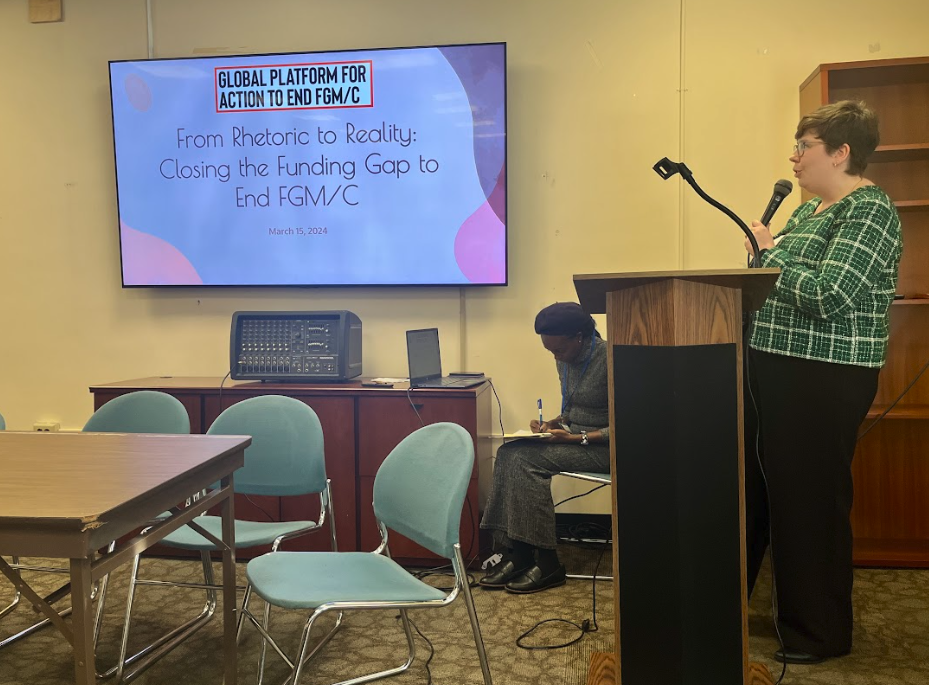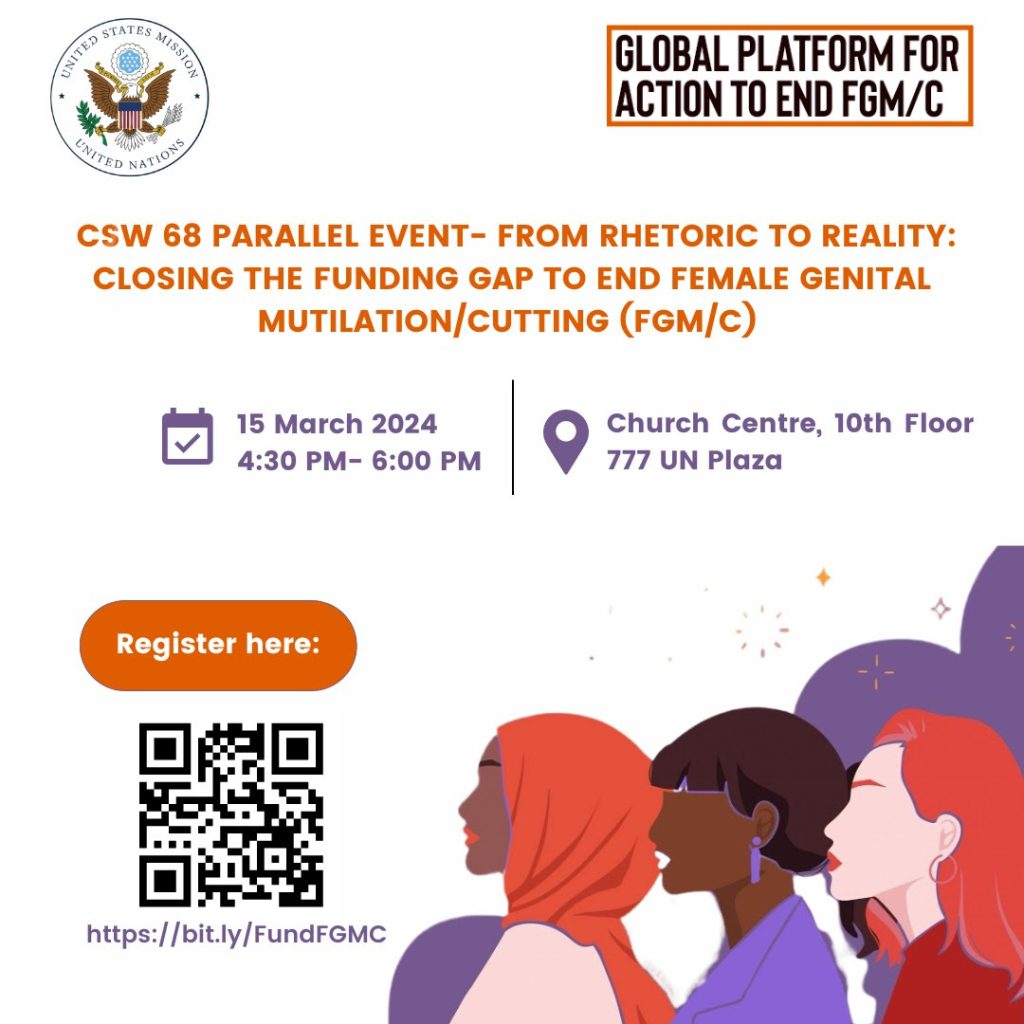Key takeaways from the “From Rhetoric to Reality: Closing the Funding Gap to End FGM/C” event

By Sheena Vasani and Mariya Taher It’s hard to believe, but in monetary terms, all it could take to avert one case of FGM/C is $95 – roughly the cost many of us pay for a year or so of Netflix. Despite that fact, one of the reasons female genital mutilation/cutting (FGM/C) is on the rise worldwide is because of a lack of adequate funding. How is that possible? That’s one of the many questions Sahiyo and other members of The Global Platform for Action to End FGM/C coalition explored on March 15th during a parallel event at the 68th Session of the Commission on the Status of Women (CSW68). Hosted by the Global Platform coalition in partnership with the United States Mission to the United Nations, the “From Rhetoric to Reality: Closing the Funding Gap to End FGM/C” event sought to educate, mobilize, and inspire stakeholders from around the world with innovative ways to close the gap. Speakers included experts and influential change-makers from around the world, including: Wisal Ahmed, Global Coordinator of the UNFPA-UNICEF Joint Programme on the Elimination of Female Genital Mutilation (FGM) Asenath Mwithigah, the CEO of Orchid Project Susan Gibbs/Sarah Roma, Director of the Women’s Rights Program at Wallace Global Fund Stephanie Baric, Senior Gender-Based Violence Technical Advisor (FGM/C & CEFMU), USAID’s Office of Gender Equality & Women’s Empowerment Sharon Armstrong, the Director-General of the Social Development Bureau at Global Affairs Canada Jaha Dukureh, the UN Women Goodwill Ambassador for Africa on FGM and child marriage, was unable to attend as she was in The Gambia working to keep a law banning FGM alive. However, she still shared with us a short video message addressing funding needs and awareness about the situation in The Gambia. Meanwhile, international conceptual artist Sophia Wallace — who is well-known for her viral project Cliteracy —also donated her art to the event. As a part of the event, Sahiyo and others presented some eye-opening – and at times, jaw-dropping – findings. For example, the world has seen a 15 percent increase in the total number of FGM/C survivors compared to data released in 2016, according to UNICEF data presented at the event. That equates to an additional 30 million people, meaning a total of 230 million girls and women alive today have undergone FGM/C. Because of this, FGM/C rates must decline globally 27 times faster if we hope to eliminate the practice by 2030. We also need $3.3 billion just to avert 24.6 million FGM/C cases in 31 priority countries by 2030, a UNFPA report reveals. Yet as only $275 million in development assistance will be spent between 2020-2030, that leaves a funding gap of over $2.1 billion. And that’s just for the 31 countries the report focused on – not the additional 60+ countries where FGC is also practiced. It’s safe to say the situation is pretty dire. And yet despite all those numbers, the event also gave us reasons to have hope. The event sought to bring together various stakeholders and government figures to help elevate conversation and commitment toward closing the funding gap. To that end, we promoted the Kigali Declaration, specifically calling for a Global Commitment Summit to significantly increase funding for FGM/C prevention and response efforts worldwide – and especially shift funding directly toward frontline, grassroots activists. UNICEF data reveals that half of the progress made in the last three decades happened in just the past 10 years alone. This rapid change reflects changing attitudes towards FGM/C – in other words, efforts by organizations like Sahiyo to change social norms are working. But to get rid of FGM/C sooner rather than later, we also need increased funding – and now. Join us in calling on governments and donors worldwide to put their money where their mouth is – sign and share the Kigali Declaration with your network, and spread the word.
From Rhetoric to Reality: Closing the Funding Gap to End FGM/C

From political to personal, ending female genital mutilation (FGM/C) requires a multifaceted approach that includes funding. Sadly, a lack of adequate funding has created a real obstacle in our effects to enact change, which is why The Global Platform for Action to End FGM/C in partnership with the United States Mission to the United Nations is hosting “From Rhetoric to Reality: Closing the Funding Gap to End FGM/C”, a parallel event at the 68 U.N. Commission on the Status of Women meetings this March. Date: Friday, March 15, 2024 Time: 4:30-6:00 PM ET Where: Church Center United Nations, 10th Floor, , New York, NY 10017 Register: https://bit.ly/FundFGMC Cost: Free This event will explore innovative options and call for solutions to close the funding gap. Event objectives include: Highlight the funding gap with an emphasis on the global nature of FGM/C and the funding needs globally. Share new findings on the landscape of FGM/C funding, identify strategic entry points. Bring in new stakeholders to commit to funding anti-FGM/C programming, promote dialogue between CSOs, activists and funders and mobilise multi-stakeholder partnerships. Secure support for a Global Commitment Summit to attract funding to the sector. Related: Reflecting on Investing in Girls and Women: Unleashing the Power of Philanthropy to End FGM/C PS: While we’re on the subject, Sahiyo’s Silent Auction fundraising event kicks off on March 6-10 while the Live Virtual Comedy Show takes place on March 7. We aim to raise $15,000 in support of our work. Click here to donate auction items, money, or sponsor the event.
